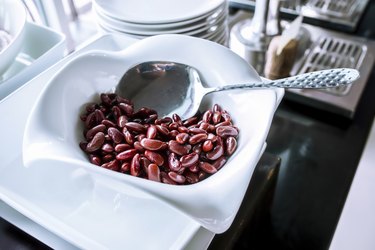
Red kidney beans and white kidney beans — also known as cannellini beans — are used in many dishes. They are a good source of dietary fiber and are considered a vegetable protein. They are low in fat and saturated fat but high in other nutrients, including calcium, iron, zinc, folate and potassium.
Kidney Bean Nutrition
Video of the Day
Beans and peas are the mature form of legumes, a vegetable protein full of nutrients and fiber. Kinds of legumes include kidney beans, pinto beans, black beans, lima beans, black-eyed peas, garbanzo beans (chickpeas), split peas and lentils, notes North Dakota State University. Beans are available most frequently in canned or dried form and sometimes in the frozen section. Beans are a good source of plant protein and contain iron, zinc, dietary fiber, folate and potassium.
Video of the Day
The United States Department of Agriculture (USDA) classifies beans as a subgroup of the vegetable group and also as part of the protein foods group. That means beans can be considered as either a vegetable or a protein in your daily food intake. A vegetarian mainstay, they are recommended for consumption as part of a balanced diet for everyone, regardless of whether or not you eat meat.
The USDA points out that 1/4 cup of cooked beans (such as black, kidney, pinto or white beans) contains about 1 ounce of protein. The amount of protein an individual should consume in a day depends on age, sex and level of physical activity, according to the USDA.
Red Beans vs. White Beans
Red kidney beans are easily identifiable by their deep red color and are marketed simply as "kidney beans." White kidney beans are sold as cannellini beans, although there are a variety of other white beans available including great northern (smaller than cannellini) and navy beans.
Dried red kidney beans need soaking and should then be boiled until they are tender because they contain toxins on the outer skin which become harmless after cooking. (Canned beans are already cooked and safe for consumption.)
In terms of nutritional benefit, and difference in red beans vs white beans is negligible. One-half cup of cooked red kidney beans without added salt contains 112 calories, less than 0.4 grams and less than 0.1 gram of saturated fat. The same serving contains no trans fat, no cholesterol, 20.2 grams carbohydrates, 6.5 grams of fiber and 7.7 grams of protein.
Read more: Does Eating Beans Help You Lose Weight?
A one-half cup serving of cooked white beans without added salt contains 104 calories, less than 0.4 grams and less than 0.1 gram of saturated fat. The same serving contains no trans fat, no cholesterol, 18.7 grams carbohydrates, 6.2 grams of fiber and 7.4 grams of protein.
How to Eat Kidney Beans
You can buy dried red or white kidney beans, notes Harvard Health. Make sure to soak them overnight or for at least eight hours before draining the water. Fill a pot with water, add the beans, bring water to a boil, then lower the temperature and cook beans until slightly tender. You may add salt later in the cooking process if desired. You may also need to skim off any foam generated while the beans are boiling.
Once the beans are cooked — or if you're using canned beans you can drain and rinse the beans and use them immediately — you can incorporate them into your cooking. Cannellini beans are delicious additions to soup, either in their whole form or pureed into a vegetable base to give substance and creaminess, or to add heft to pasta dishes. Cannellini beans can be used in place of chickpeas in a hummus recipe for a slightly different flavor.
Red kidney beans are ubiquitous in dishes such as red beans and rice. (You could also make red beans and rice with white beans.) Try mixing red, white and black beans to make a hearty vegetarian chili. You'll also find kidney beans in vegetable soups, bean salads and many more main dishes.
Read more: The Side Effects of Beans
- USDA ChooseMyPlate: "Beans and Peas Are Unique Foods"
- USDA ChooseMyPlate: "All About the Protein Foods Group"
- North Dakota State University: "All About Beans Nutrition, Health Benefits, Preparation and Use in Menus"
- Harvard Health Publishing, Harvard Women's Health Watch: "Legumes: A Quick and Easy Switch to Improve Your Diet"